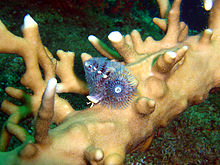User:TrevellP/Spirobranchus corniculatus
Article Drafting: Spirobranchus corniculatus
[edit]Comments by A. Faucci (Apr 3, 2024):
Nice work on finding lots of great information. To polish your draft before copying it over to the main article please work on the following:
- Looks like somebody added some info recently, so make sure you delete that part or better, combien it with your information.
- Make sure your sentences are all in perfect English and grammar and are easily understandable for a worldwide audience. Several of your sentences are not full sentences! Don't use subheadings within a paragraph (diet:.... etc.)
- Make sure you start general and go into more details as you go along within a section. For example: Distribution & Habitat: start more general with the geographic distribution (Spirobranchus corniculatus can be found in the tropical Indo-Pacific, including ...... ) before talking about specific places or habitat.
- References: Make sure you use the "cite function correctly. Looks like your reference 3 is actually 2 sentences.
Lead
[edit]Spirobranchus corniculatus, commonly referred to as the Indo-Pacific Christmas tree worm, belongs to the family Serpulidae and is a species of tube-building annelid fanworms. Belonging to the class Polychaeta, they are recognized for their bristle-like tentacles and the presence of a structure called radioles. It is widely encountered and recognized for its unique resemblance to a conifer and its diverse array of colors. Initially presumed to be part of a species group including Spirobranchus cruciger and Spirobranchus gaymardi, it has been determined to be a singular, morphologically adaptable species inhabiting the Central Indo-Pacific region.
Description
[edit]The Christmas tree worm is very vibrant in color and changes its color based on depth, camouflage, and a scare tactic.[1] It has bright spiral rings around its body segments or radioles, which can even number more than 200 segments.[2] The body of the Serpulidae is abnormally large, ranging up to 45 mm long and 0.5 mm wide.[2]
Biology
[edit]The species within the Spirobranchus corniculatus class predominantly engage in reproduction throughout their lifespan. During mating, females emit a pheromone that attracts and signals males to release sperm. In turn, females release eggs; this action is called spawning.[3] The life cycle of Polychaeta commences with egg development into larvae, characterized by an elongated body, which will then reach juvenile stages. Eventually, after a while, they reach the end of their lifespan.[4] They also use their color to attract females and use their mesmerizing color to make predators second guess their meal. Regarding their diet, they primarily consume suspended food particles, phytoplankton, and microalgae.[1]
Distribution and Habitat
[edit]Spirobranchus corniculatus can be found in the tropical Indo-Pacific, specifically in corals such as (Porites lobata), which are typically found in Hawaiian waters.[2] The Christmas tree worm inhabits depths of up to 3-30 meters[4] and can also be found living in almost every species of coral.[1] It is mostly encountered in the eastern side of the globe, spanning Southeast Asia, the Indian Ocean, the central Pacific, and the northern region of Australia.[1]
Pictures
[edit]

References
[edit]- ^ a b c d Perry, Orly; Sapir, Yuval; Perry, Gad; Hove, Harry Ten; Fine, Maoz (2018-06). "Substrate selection of Christmas tree worms (Spirobranchus spp.) in the Gulf of Eilat, Red Sea". Journal of the Marine Biological Association of the United Kingdom. 98 (4): 791–799. doi:10.1017/S0025315416002022. ISSN 0025-3154.
{{cite journal}}: Check date values in:|date=(help) - ^ a b c Reef and shore fauna of Hawaii. 2/3. Bishop Museum special publication. Honolulu, Hawai'i: Bishop Museum Press. 1987. ISBN 978-0-930897-11-6.
- ^ Idris, Izwandy; Mohd-Salleh, Nadia Azeera; Ahmad Fadzil, Nur Dalia Natasya (2022), "Host Preferences and Colouration of Christmas Tree Worms, Spirobranchus corniculatus (Grube, 1862) from Bidong Island, South China Sea", Bidong Island, Cham: Springer International Publishing, pp. 177–187, ISBN 978-3-030-91923-8, retrieved 2024-03-04
{{citation}}: no-break space character in|title=at position 99 (help) - ^ a b "Spirobranchus corniculatus". www.sealifebase.ca. Retrieved 2024-03-04.
